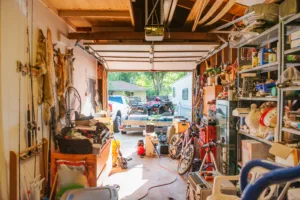Agnieszka and Pawel Wardanski’s home at 10 Cynthia Crescent, Springwood that they acquired in 2003, adjoined that of Karen Mawby and Scott Marks who acquired their residence in 2014.
Neither conducted a survey to confirm the boundary line between the properties or that the boundary fence – constructed decades earlier – was in the correct position.
 For several years, they lived happily next door to each other, each in the mistaken belief that the fence sat precisely on the boundary.
For several years, they lived happily next door to each other, each in the mistaken belief that the fence sat precisely on the boundary.
When Mawby/Marks began renovations on their property in July 2017 it was discovered in the course of a survey that the Wardanski property extended beyond the fence line and includes part of the land former believed was theirs.
They kept the matter to themselves for about 12 months until they met with their neighbours to seek consent for boundary works purportedly at the request of their builder.
What they proposed was an easement that would have allowed the encroaching structures to remain but withheld the survey plan from the Wardanskis so as not to reveal the extent of the problem.
Realising what was afoot, Wardanski demanded the removal of the encroaching structures – a retaining wall, garden shed, gardens and part of a garage – and for the area of land of about 9 m2 extending along the entire 30m common boundary to be surrendered.
Mawby/Marks on the other hand – because of the huge costs they would incur in removing the encroachment – proposed a boundary realignment, which would allow them to acquire that part of the Wardanski land on which the encroachments stood so that those structures – and further improvements that continued to conduct – could be retained.
Project manager Beverly Hollands estimated the removal cost on their behalf, at $221,013, plus GST.
Wardanski then set about designing improvements – a garage – to take advantage of their newly-discovered land holding. They requested builder Kent Jenner identify the costs of that renovation as well as the estimated costs their neighbours would incur to remove the encroachment.
In August 2019 with no agreement in sight, Wardanski’s lawyers demanded the neighbours ‘cease and desist’ carrying out any repairs and refurbishments to the encroaching structures.
When that was largely ignored, they applied to Queensland’s Supreme Court for an order pursuant to s 185(1)(c) of the Property Law Act for the encroachments to be removed and in the alternative $185,000 for the costs of modifications to the design and construction of their garage and other losses.
It was not in dispute that Mawby/Marks were liable for the encroachment notwithstanding it had been “inherited”.
They contented that Wardanski never held any intentions to build a garage or deck extension and that it was simply a ‘device’ to justify removal of the encroachment.
While rejecting that submission, Justice Lincoln Crowley was of the view that the plaintiffs’ insistence on the removal of the encroachment so they could build their proposed garage and their unwillingness to consider potential alternative solutions that did not involve demolishing or moving the neighbour’s garage, to have been unreasonable.
He accepted the evidence of civil engineer and project manager Bradley Schaper that it is feasible for the Plaintiffs to construct an adequately sized, enclosed double car garage on their property – albeit absent the storage they desired – without removal of the neighbour’s garage.
While their rejection of the neighbour’s settlement offers was a continuation of their unreasonable conduct, the judge noted the matter was not to be determined, “by deciding whose conduct has been the most virtuous”.
“Whilst I am mindful that the Plaintiffs are the owners of the land and that their property rights ought not be lightly interfered with,” he ruled “it is abundantly clear in this case that the prejudice that to the Defendants – as ‘largely innocent encroachers’ – by an order for removal of the encroachment outweighs the prejudice that to the Plaintiffs if no such order were made”.
He ordered that Mawby/Marks pay Wardinski $16,087.50, being three times the unimproved capital value of the land burdened by the encroachment which was to be transferred to them and $5,000, for the resulting diminution in the value of their property.
There was also a retaining wall that a builder had constructed negligently on part of the Wardinski land. The court considered that to be de minimus, ie so trivial that it was of no concern.
Wardinski requested in relation to any land transfer, that it be of the total 19m2 piece of land, being the area between the existing fence and the true boundary.
Justice Crowley rejected that submission holding that the Court’s power under s 185(1)(b) is limited to ordering the transfer of the land over which an encroachment extends.
Wardanski & Anor v Mawby & Anor [2023] QSC 136 Crowley J 18 August 2023




0 Comments